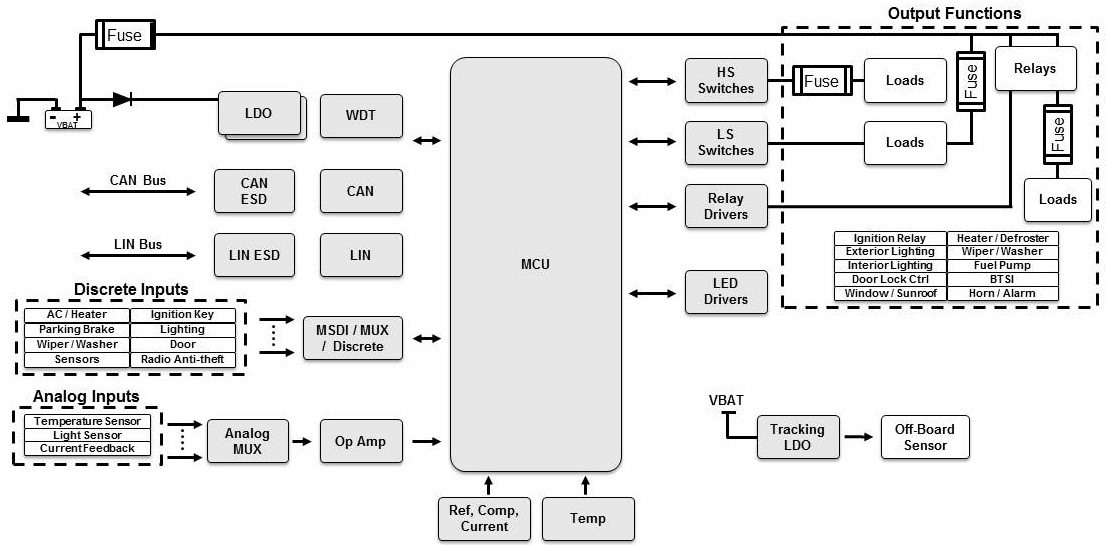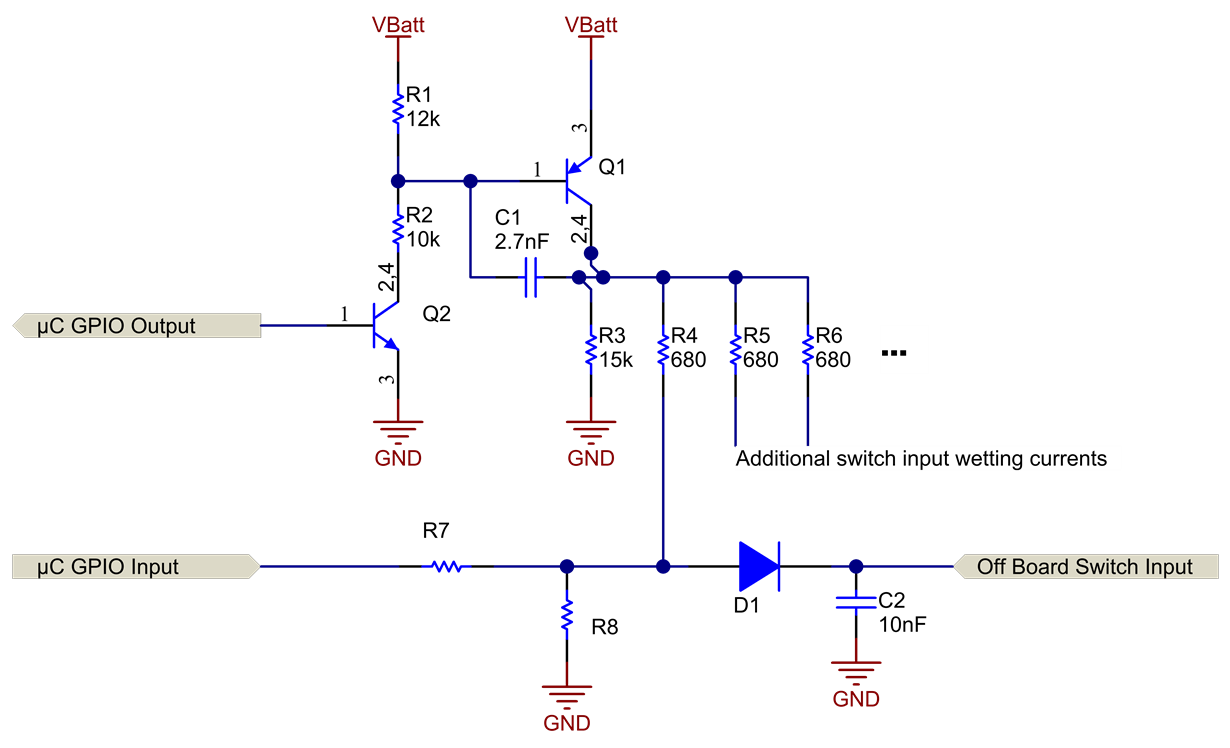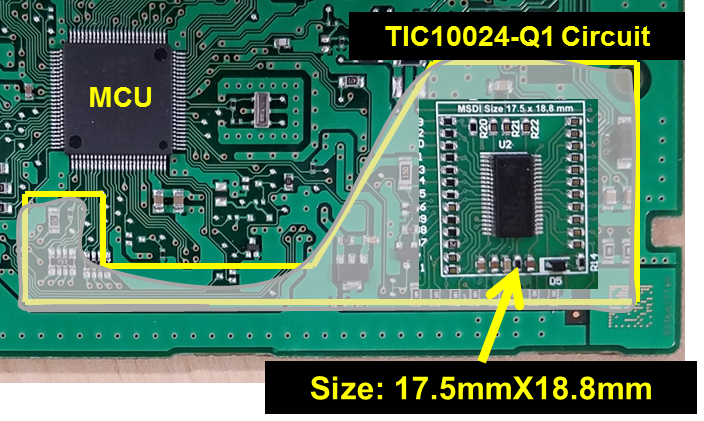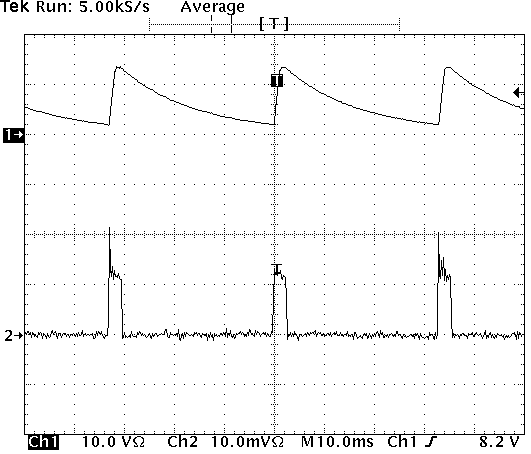SSZT936 october 2017 TIC12400-Q1
John Griffith
Automotive body control modules (BCMs) are electronic control units that manage numerous vehicle comfort, convenience and lighting functions, including door locks, windows, chimes, closure sensors, interior and exterior lighting, wipers, and turn signals. Specifically, BCMs monitor different driver switches and control power to corresponding loads in a car, as shown in Figure 1.
 Figure 1 BCM Block Diagram
Figure 1 BCM Block DiagramA typical BCM consists of a microcontroller (MCU) that processes automotive 12V battery level driver switch states. The signals connect to the MCU through interface circuits traditionally implemented using discrete passive components such as resistors, capacitors and diodes. You must take care to protect the MCU from battery level voltages, electrostatic discharge (ESD), transients and reverse-battery conditions. Additionally, you need to provide wetting currents for biasing the switch inputs and to keep the switch contact in good condition.
Figure 2 shows an example implementation of how to handle an external ground-connected switch input. Capacitor C2 shunts ESD and transient energy; diode D1 blocks high voltages; resistor R4 sets the wetting current at the switch; resistor R4 (in conjunction with R8) divides the battery level voltages down; and resistors R1 through R3, transistors Q1 and Q2, capacitor C1, and a general-purpose input/output (GPIO) pin enable and disable the wetting currents.
 Figure 2 Discrete Wetting Current
Implementation
Figure 2 Discrete Wetting Current
ImplementationThere are three caveats to this discrete approach:
- The MCU, and therefore the MCU’s supply voltage, have to remain active for the wetting currents to be active. This severely affects the minimum amount of current that the module consumes when in low power (key-off) mode.
- The solution requires a large number of passive components, such as transistors and resistors for creating the wetting currents, as well as diodes, resistors and capacitors for each switch input. This makes the overall solution size large.
- The wetting current will vary with battery voltage; for example, if the battery voltage droops by 30%, the wetting current will also droop by 30%.
A multiswitch detection interface (MSDI) is a device that handles all of these issues, aggregating battery- and ground-connected switch status information and communicating back to a microprocessor via the serial peripheral interface (SPI).
Features for Smaller, More Space-Efficient Solutions
MSDI devices have integrated adjustable wetting currents capable of both sinking and sourcing currents for both battery- and ground-connected external switch inputs. Since these currents are internally monitored and controlled, they remain consistent over a wide range of battery input voltages. MSDI switch inputs are also designed to handle load dump and reverse-battery voltages, alleviating the need for discrete blocking diodes and wetting current components and thus saving additional board area and cost. A discrete 24-channel solution – implemented as shown in Figure 2 – would use 75 resistors, 25 capacitors, 24 diodes and two external transistors. A comparable solution using the TI TIC12400-Q1 integrated MSDI solution would use 24 capacitors for IO pins, 5 capacitors for decoupling, a single resistor for the interrupt output and a single MSDI device.
Figure 3 shows a 1-to-1 comparison of the solution size for discretely handling the wetting current, reverse blocking and ESD on switch inputs and a snippet of the Automotive Multi-Switch Detection Interface reference design, which is an example implementation using the TIC12400-Q1 device with all of its required external circuitry. The total solution size on a two-layer board with the MSDI reference design is now 17.5 mm by 18.8 mm.
 Figure 3 TIC12400-Q1 Solution
Size
Figure 3 TIC12400-Q1 Solution
SizeFeatures for More Efficient Low-Power Modes
As I mentioned before, to monitor an external switch in low-power mode, the microprocessor needs to remain powered on and active, meaning that the MCU’s regulator also needs to remain active at all times. This results in higher system-wide quiescent current in low-power mode.
MSDI devices run directly off of car batteries and have an integrated low-power polling mode that makes it possible to monitor user-selected switch contacts. For example, the TIC12400-Q1 has a low-power polling mode and a high-voltage open-drain interrupt output pin that can enable a regulator upon a switch status change. This means that you can shut off all other circuitry in the module for an ultra-low-power sleep mode, helping meet tighter and tighter original equipment manufacturer (OEM) current requirements for sleep mode.
Figure 4 shows an oscilloscope screenshot where the TIC12400-Q1 is in low-power polling mode. Channel 1 shows the voltage at an open switch contact, and channel 2 shows the current consumption of the device.
 Figure 4 Low-Power Polling Mode with
Switch Monitoring
Figure 4 Low-Power Polling Mode with
Switch MonitoringAs you can see, the device is enabling the wetting current, monitoring the input voltage and returning to low-power mode repeatedly while waiting for a switch contact to change state. This results in a much lower average current for the module, since all other circuitry in the module is disabled.
With the number of features in BCMs growing every year, the addition of an intelligent device like MSDI with integrated wetting currents, reverse blocking and ESD protection helps enable smaller switch-contact monitoring solutions. In addition, as requirements for current consumption in low-power mode tighten, the integrated low-power polling mode in the TIC12400-Q1 enables system-wide power savings by as much as 98%.
Additional Resources
- Learn more about the TIC12400-Q1 MSDI device.
- Watch an introductory video about the Automotive Multi-Switch Detection Interface reference design.